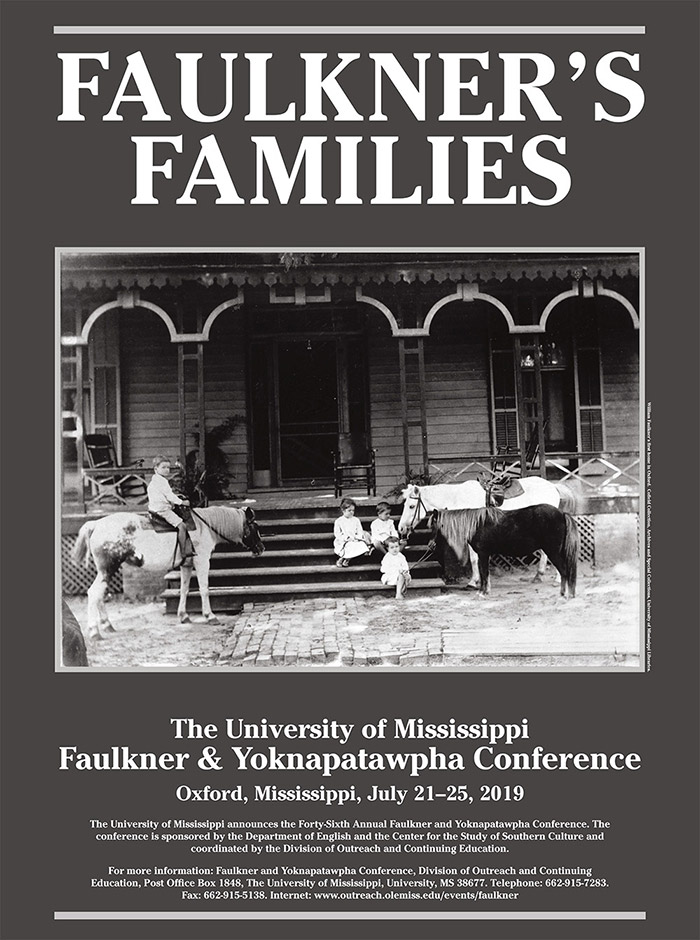
Panel. Toxic, Contagious, and Stressed: Family Pressures in Faulkner
Location
Nutt Auditorium
Start Date
23-7-2019 11:00 AM
Description
- The Toxic Compsons and the Homeopathic Poison Remedies / Geri Harmon, Georgia Gwinnett College
My paper argues that descriptions of psycho-biological traits published in the popular homeopathic manuals of the day informed Faulkner’s character portrayals of the Compson family in The Sound and the Fury. Each Compson family member embodies concurrently published homeopathic portraits. Faulkner might have known about a few common remedies derived from poisons for treating alcoholism: Lachesis, Nux Vomica, and Phosphorus. These remedies’ portraits describe the Compson men. Caroline most closely matches another popular poison remedy, Sepia. Faulkner’s own alcoholic treatments (The Keeley Cure) offered him opportunities to participate in alternative medical treatment, and his own beliefs about a divinity present in us would have supported the older, more romanticized, homeopathic ideas based on mind-body typology to balance an invisible vitalism and bring about good health. The diagnostic descriptions in these manuals for those needing these specific poison remedies dominate the Compson family, thus both anticipating and sealing their toxic fate. - "Dilsey, I Want My Mother": The Modernist Alignment with Maternal Anger in The Sound and the Fury / Margaret Mauk, Florida State University
- Attachments, Deprivations, and Breakups: Neo-Bowlbian Families and Faulkner’s Pylon / Michael Wainwright, Royal Holloway, University of London
This paper traces the prescience of William Faulkner’s Pylon beyond the premonitory orbit of Dean Falkner’s demise. The year is 1935. In March, Faulkner’s novel appears in print. In November, Faulkner’s youngest brother dies in a plane crash. That same year, British psychiatrist John Bowlby reads Ian Suttie’s newly published The Origins of Love and Hate, which stresses the therapeutic importance of physician to patient relations. The Scottish psychiatrist’s proposition strikes Bowlby as evidence of a credible alternative to Freud’s doctrine of drives, evidence that Bowlby painstakingly develops into a theory of attachment: the healthy standard of maternal devotion finding its unhealthy counterpart in maternal deprivation. Like Bowlby, the interwar Faulkner not only distances himself from Freud, but also contemplates family breakups; as Pylon reveals, however, Faulkner does so in mitigating the influence of gender, thereby anticipating advances to Bowlbian theory. - The Yoknapatawpha Outbreak: An Epidemiological Reading of the Snopes Family / Maxwell Cassity, Syracuse University
Relational Format
Conference proceeding
Recommended Citation
Harmon, Geri; Mauk, Margaret; Wainright, Michael; and Cassity, Maxwell, "Panel. Toxic, Contagious, and Stressed: Family Pressures in Faulkner" (2019). Faulkner and Yoknapatawpha Conference. 16.
https://egrove.olemiss.edu/fy/2019/schedule/16
COinS
Jul 23rd, 11:00 AM
Panel. Toxic, Contagious, and Stressed: Family Pressures in Faulkner
Nutt Auditorium
- The Toxic Compsons and the Homeopathic Poison Remedies / Geri Harmon, Georgia Gwinnett College
My paper argues that descriptions of psycho-biological traits published in the popular homeopathic manuals of the day informed Faulkner’s character portrayals of the Compson family in The Sound and the Fury. Each Compson family member embodies concurrently published homeopathic portraits. Faulkner might have known about a few common remedies derived from poisons for treating alcoholism: Lachesis, Nux Vomica, and Phosphorus. These remedies’ portraits describe the Compson men. Caroline most closely matches another popular poison remedy, Sepia. Faulkner’s own alcoholic treatments (The Keeley Cure) offered him opportunities to participate in alternative medical treatment, and his own beliefs about a divinity present in us would have supported the older, more romanticized, homeopathic ideas based on mind-body typology to balance an invisible vitalism and bring about good health. The diagnostic descriptions in these manuals for those needing these specific poison remedies dominate the Compson family, thus both anticipating and sealing their toxic fate. - "Dilsey, I Want My Mother": The Modernist Alignment with Maternal Anger in The Sound and the Fury / Margaret Mauk, Florida State University
- Attachments, Deprivations, and Breakups: Neo-Bowlbian Families and Faulkner’s Pylon / Michael Wainwright, Royal Holloway, University of London
This paper traces the prescience of William Faulkner’s Pylon beyond the premonitory orbit of Dean Falkner’s demise. The year is 1935. In March, Faulkner’s novel appears in print. In November, Faulkner’s youngest brother dies in a plane crash. That same year, British psychiatrist John Bowlby reads Ian Suttie’s newly published The Origins of Love and Hate, which stresses the therapeutic importance of physician to patient relations. The Scottish psychiatrist’s proposition strikes Bowlby as evidence of a credible alternative to Freud’s doctrine of drives, evidence that Bowlby painstakingly develops into a theory of attachment: the healthy standard of maternal devotion finding its unhealthy counterpart in maternal deprivation. Like Bowlby, the interwar Faulkner not only distances himself from Freud, but also contemplates family breakups; as Pylon reveals, however, Faulkner does so in mitigating the influence of gender, thereby anticipating advances to Bowlbian theory. - The Yoknapatawpha Outbreak: An Epidemiological Reading of the Snopes Family / Maxwell Cassity, Syracuse University

